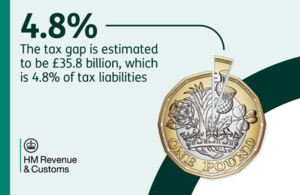Tax gap holds steady at 4.8%
The estimated tax gap for the 2021 to 2022 tax year is at an all-time low of 4.8%.

The amount of unpaid UK tax has remained at an all-time low of 4.8%, HM Revenue and Customs (HMRC) revealed today (22 June).
The annual Measuring Tax Gaps publication estimates the difference between the total amount of tax expected to be paid and the total amount of tax actually paid, which has remained the same as last year’s revised estimate of 4.8%.
Jonathan Athow, HMRC’s Director General for Customer Strategy and Tax Design, said:
The tax we collect funds the country’s public services and we want to ensure everyone pays the correct amount. These figures show most taxpayers and businesses pay what they should.
This important research enables us to better help those making common mistakes or failing to take sufficient care, as well as tackling the minority deliberately hiding their income.
The report, published annually, show a long-term reduction in the tax gap. Errors, a lack of sufficient care, evasion and criminal attacks all contribute to the tax gap, which has fallen from 7.5% in 2005 to 2006 to 4.8% in 2021 to 2022.
In monetary terms, the most recent figures put the difference at £36 billion for the 2021 to 2022 tax year. This has increased from £31 billion in 2020 to 2021.
The tax gap has remained at 4.8% because estimated tax liabilities rose from £643 billion in 2020 to 2021 to £739 billion in 2021 to 2022.
Further findings for the 2021 to 2022 tax gap publication show:
- at 56% (£20.2 billion), small businesses represent the largest proportion of the tax gap by group, followed by criminals, large businesses and mid-sized businesses at 11% each (£4.1 billion, £3.9 billion and £3.8 billion respectively)
- wealthy individuals account for 5% (£1.7 billion) while all other individuals account for the remaining 6% (£2.1 billion) of the overall tax gap
- Income Tax, National Insurance contributions and Capital Gains Tax makes up 35% (£12.7 billion) of the total tax gap when measured by type of tax
- Corporation Tax (CT) is now estimated as the second largest component of the tax gap by tax type at 30% (£10.6 billion). New data has increased our understanding of the CT tax gap, resulting in revised estimates
- the VAT gap continues a long-term downward trend falling from 14.0% (£11.9 billion) in 2005 to 2006 to 5.4% (£7.6 billion)
- failure to take reasonable care (30%), error (15%), evasion (13%), legal interpretation (12%) criminal attacks (11%) and non-payment (9%) are among the main behavioural reasons for the tax gap
HMRC publishes the tax gap because it believes transparency in its work is important. The report aims to enhance public trust in the tax system and in HMRC’s ability to support taxpayers in meeting their obligations and pay the tax they owe. It also helps inform the future work and priorities of HMRC and highlights the areas where it can make the greatest difference.
HMRC is the only tax authority in the world that measures and publishes an annual tax gap in such a comprehensive way – covering a single tax year for all the taxes, levies and duties it administers.
Every year, HMRC estimate the tax gap using the most up to date information available, however, figures may be revised as more data becomes available.
Further information
The Measuring Tax Gaps 2023 report was published today 22 June 2023.
The Measuring Tax Gaps 2022 report was published on 23 June 2022 and estimated the tax gap for the 2020 to 2021 tax year at 5.1%. This figure has been revised down to 4.8%.
HMRC’s tax gap estimates are official statistics produced in accordance with the Code of Practice for Statistics, which assures objectivity and integrity. Tax gap estimates are reviewed each year to reflect updated data and methodologies.